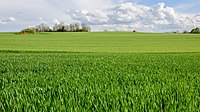
Photo from wikipedia
This work proposes an analytical strategy utilizing digital images (DI) for the iron inorganic speciation in white wine. The method was established by the reaction of iron(II) ions with 1,2… Click to show full abstract
This work proposes an analytical strategy utilizing digital images (DI) for the iron inorganic speciation in white wine. The method was established by the reaction of iron(II) ions with 1,2 ortho-phenanthroline as a chromogenic reagent. Total iron was determined using the same reagent after the addition of hydroxyl ammonium chloride as a reducing agent. In both cases, digital images of the standards/chromogenic reagent and samples were acquired and stored in JPEG format. The region of interest (ROI) was determined with a constant square shape for all images. The ROI was submitted to decomposition in color values according to the RGB additive color model. However, the data obtained by the blue channel was the one used in the construction of the analytical curves because it presented the highest sensitivity. The optimization of the experimental conditions of the procedure was performed by employing multivariate techniques. The precision was evaluated using a wine sample with iron (II) and total iron contents of 0.41 and 0.69 mg L-1, respectively. The results expressed as relative standard deviations were 3.57% for iron (II) and 4.76% for total iron contents. A comparison between the results obtained for total iron by the DI method with the results found using flame atomic absorption spectrometry confirmed the method accuracy. The DI procedure was applied for speciation analysis in six white wine samples and the contents found varied from 0.41 to 1.67 mg L-1 for iron (II) and from 0.69 to 1.71 mg L-1 for total iron. These results are in agreement with those found for speciation analysis of iron in wine samples. Iron (III) contents can be found by the difference between the total iron and iron (II) contents.
Journal Title: Talanta
Year Published: 2019
Link to full text (if available)
Share on Social Media: Sign Up to like & get
recommendations!